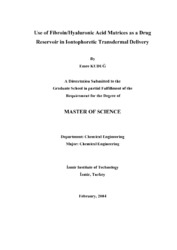Please use this identifier to cite or link to this item:
https://hdl.handle.net/11147/3402Full metadata record
| DC Field | Value | Language |
|---|---|---|
| dc.contributor.advisor | Batıgün, Ayşegül | - |
| dc.contributor.author | Kuduğ, Emre | - |
| dc.date.accessioned | 2014-07-22T13:51:28Z | - |
| dc.date.available | 2014-07-22T13:51:28Z | - |
| dc.date.issued | 2004 | - |
| dc.identifier.uri | http://hdl.handle.net/11147/3402 | - |
| dc.description | Thesis (Master)--Izmir Institute of Technology, Chemical Engineering, Izmir, 2004 | en_US |
| dc.description | Includes bibliographical references (leaves: 62-67) | en_US |
| dc.description | Text in English; Abastract: Turkish and English | en_US |
| dc.description | x, 67 leaves | en_US |
| dc.description.abstract | Transdermal drug delivery is gaining importance due to the extensive research in genetics and resulting increase of protein and peptide based drugs in the market. In order to develop materials to be used in iontophoretic transdermal drug delivery systems, various forms of silk fibroin (SF) and blending agents as hyaluronic acid (HA) have been tested for their feasibility as a potential drug reservoir. For this purpose different forms of silk such as raw silk, degummed silk fibroin, insolubilized freezedried fibroin, membranes of fibroin in pure and blended with HA were investigated for their adsorption capacities of timolol maleate, which is used as the model drug. It was found that silk fibroin and derivatives have considerable adsorption capacities for timolol maleate with 0.35 mmol per gram, comparable with commercial membranes. The insolubilization of the membranes was required for drug loading and delivery in aqueous media. Membrane insolubility was achieved by post treatment, manipulation of drying conditions, and blending with different agents. Configurational changes of fibroin protein and interactions between silk fibroin and hyaluronic acid were investigated by Fourier transform infrared spectroscopy, scanning electron microscopy, and X-ray diffraction analyses. Insoluble fibroin glutaraldehyde membranes were produced. The obtained insoluble membranes were investigated for drug delivery performance in a custom-made diffusion cell under passive diffusion and iontophoretic conditions. It was demonstrated that the silk fibroin glutaraldehyde films could be successfully used for controlled drug delivery. It was found that current densities of 1.5 and 3 mA/cm2 were suitable to accomplish controlled delivery of the drug in a pulsatile manner. The results of this study are expected to be useful in controlled transdermal delivery of positively charged drug molecules. | en_US |
| dc.language.iso | en | en_US |
| dc.publisher | Izmir Institute of Technology | en_US |
| dc.rights | info:eu-repo/semantics/openAccess | en_US |
| dc.subject.lcc | RM151 .K95 2004 | en |
| dc.subject.lcsh | Transdermal medication | en |
| dc.subject.lcsh | Drug delivery systems | en |
| dc.subject.lcsh | Iontophoresis | en |
| dc.title | Use of Fibroin/Hyaluronic Acid Matrices as a Drug Reservoir in Iontophoretic Transdermal Delivery | en_US |
| dc.type | Master Thesis | en_US |
| dc.institutionauthor | Kuduğ, Emre | - |
| dc.department | Thesis (Master)--İzmir Institute of Technology, Chemical Engineering | en_US |
| dc.relation.publicationcategory | Tez | en_US |
| dc.identifier.wosquality | N/A | - |
| dc.identifier.scopusquality | N/A | - |
| item.grantfulltext | open | - |
| item.fulltext | With Fulltext | - |
| item.openairecristype | http://purl.org/coar/resource_type/c_18cf | - |
| item.openairetype | Master Thesis | - |
| item.languageiso639-1 | en | - |
| item.cerifentitytype | Publications | - |
| Appears in Collections: | Master Degree / Yüksek Lisans Tezleri | |
Files in This Item:
| File | Description | Size | Format | |
|---|---|---|---|---|
| T000297.pdf | MasterThesis | 1.71 MB | Adobe PDF |  View/Open |
CORE Recommender
Page view(s)
294
checked on Aug 4, 2025
Download(s)
120
checked on Aug 4, 2025
Google ScholarTM
Check
Items in GCRIS Repository are protected by copyright, with all rights reserved, unless otherwise indicated.